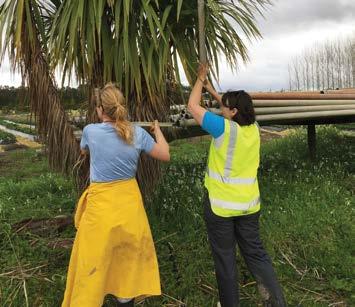
9 minute read
Cocktail tomatoes: red is the new black
WISE LAND MANAGEMENT
A WIN-WIN
By Kristine Walsh
Connecting science and farming – researchers and growers cooperating in a field trial
Dan Bloomer has great faith in growers' desire to do the right thing in terms of nutrient management, and works hard to help them do it.
“Over the course of my working life I've come to the conclusion that if I want farmers to be environmentally better, I have to show they'll be economically better off, too,” he says. “To me, it doesn't matter whether they want to save a bit of money while happening to do the right thing environmentally, or whether their focus is on sustainability with a bonus at their bottom line. The result is the same.”
Founder of both Page Bloomer Associates consultancy and the farmer-driven LandWISE society to promote sustainable cropping, Dan's work encourages environmentally sound land practices through projects like LandWISE's Future Proofing Vegetable Production (FPVP), where it has partnered with growers and funders to develop and test nitrogen application and mitigation. “Horizons Regional Council was right behind us in putting together a research and extension programme which we have with funding from them, the Ministry for Primary Industries, Ballance AgriNutrients, Gisborne District Council and Potatoes NZ, along with the support of growers.” Working with growers in Horowhenua and Gisborne, the three-year LandWISE trial focuses on four key areas:
1
2
3
4
working out how much nutrient is required; ensuring the right amount is being applied; ensuring leaching is minimised; and recapturing nitrates that do move beyond the root zone by constructing wetlands and wood-chip bioreactors.
“Growers can feel overwhelmed by the avalanche of regulations and consumer demands, so we want knowledge of best practice to be as accessible and usable as possible,” Dan says. “Growers needed nutrient budgets but there wasn’t a suitable template so we made one. It’s a one-pager that pulls together their soil test information, expected yields, the Nutrient Management for Vegetable Crops book information and their fertiliser options. “At the end of the season, they can repeat the process using actual yield and fertiliser and see how close the inputs and outputs matched. And now we’re working on an app so they can do it on their phones. “Similarly, calibrating a fertiliser applicator is simple once you know how, so we made the LandWISE calculator (www.fertspread.nz) to do the maths and print off a report.” The only times he's seen resistance, he adds, is when a grower has thought it was all going to be too hard. “But we've found that if we offer good information in a form that makes sense, and if we take time to understand and answer their questions, they're very quick to adopt great practice.” In Horowhenua, LandWISE agronomist Luke Posthuma has worked with growers producing leafy greens or potatoes, while in the second trial area, Gisborne, process crops like sweetcorn and tomatoes have been more of a focus.
Last year Gisborne had a really dry winter, so without rain washing out the nitrate, levels were higher than usual so much less fertiliser was required. Luke saw that in his data, so this season he’s working with growers to trial use of nitrate Quick Test strips to determine nitrogen requirements at side-dressing. “It's about responding to actual need, rather than just doing what has always been done, and in both Gisborne and Horowhenua we've been working with some great growers, corporate and otherwise, who are really interested in this kind of work, so that's fantastic,” says Luke. It is very hard to measure nitrate losses and modelling tools are not strong for vegetable crops, and Dan doesn't see that changing any time soon. “But it is easy enough to consider on your farm and that is how the nutrient balance sheet can help,” he says. “If you are putting X kilos of nitrogen on a crop, and you sell produce containing Y kilos, then where did the rest of it go? If a fertiliser budget is out by hundreds of kilograms, then you need to do things differently.” Through the FPVP project LandWISE recommends a toolkit made up of “cheap as” nitrate soil testing strips, lab tests where necessary, knowledge about good practice and the super easy nutrient sheet to help growers balance their nutrient budget. And it is that, plus other handy information, that they hope to take on tour once FPVP comes to an end in June next year. “We have all these lessons, we know how to effectively engage and share information and that – perhaps with some more regionally-specific demonstration trials – is what we'd really like to roll out around the country,” Dan says. “There is agreement that it is necessary so it's just a matter of getting the funding in place, and we're really keen to see that happen. “Workshops and demo days are great, but it's when you actually sit on a farm and engage that real change happens, and to me that’s the whole point.” But even farmers not involved with the FPVP project don't have to wait to get on board. “Any farmer can access our website, download the budget sheet, access the fertspread calibration site and so on. Some growers will learn that they need a little bit more fertiliser, but many will find they can use less, and that's potentially thousands of dollars that's not just washing away into the environment.” The best thing about the Future Proofing project, says Dan Bloomer, is that it has been embraced by “even the most unlikely-looking blokes.” “In general, I think everyone is on board with change as long as they are in control,” he says. “Tools and projects like ours are a way of handing them that control so they can grow better crops for less cost, and help the environment while they're at it.”












FUTURE-PROOFING
STRAWBERRIES

Words by Mette Nielsen : Scientist, Plant & Food Research
The AGMARDT fellow Dr Paul Horne from IPM Technologies in Australia presenting to NZ strawberry growers and wider industry at the field day in January 2020

In July, the first year of research was concluded in the Sustainable Farming Fund (SFF) project ‘Future-proofing thrips management in strawberries’ (SFF405943).
Our aim is to increase knowledge and develop and implement new tools and management techniques to manage thrips in strawberry production in New Zealand, transforming the current Integrated Pest Management (IPM) strategy. Past practices to manage thrips are currently heavily reliant on non-selective insecticides, but control failures and the unsustainability of this practice mean it is not an option for future production. It is also a barrier to the successful implementation of currently industry-developed IPM strategies for pest management. The knowledge generated in this project will enable growers to minimise economic damage of pest thrips and enable an overall IPM strategy to be implemented across New Zealand strawberry production. The project is a collaboration between the New Zealand Institute for Plant & Food Research Limited and Berryworld Limited. In the first year, we conducted a grower survey, field trials, a growth room pot trial, and a literature review on thrips pest species and management options in strawberry crops. The team was also active with end-user engagement activities, and obtained additional funding from AGMARDT (The Agricultural & Marketing Research & Development Trust), enabling the involvement of overseas IPM expert Dr Paul Horne.
Four field trials were conducted from October 2019 to April 2020 at strawberry growers in Auckland, Hawke’s Bay and Canterbury, covering different growing systems. We used blue sticky traps and visual observations in the strawberry crop and surrounding vegetation to determine which thrips species were present. This was unknown at the start of the project and is critical information to develop pest management strategies. We also determined thrips phenology (when insect life stages occur) and presence of their natural enemies.
The species of thrips in strawberry crops varied among growers, and there were large differences in seasonality and pest pressure. The main thrips species caught in the strawberry crops were intonsa flower thrips (Frankliniella intonsa), western flower thrips (Frankliniella occidentalis), onion thrips (Thrips tabaci) and New Zealand flower thrips (Thrips obscuratus); however, their dominance, pressure and peak times varied depending on the growing system and location. fruit. The results showed that the damage potential of intonsa flower thrips on strawberry fruit is severe. Western flower thrips also damaged the fruit, whereas the damage potential of onion thrips is still questionable. Unfortunately because of difficulties rearing New Zealand flower thrips, this species was not tested, and to date its damage potential is unknown.
Based on the knowledge gained in year 1, the team concludes that a ‘one-size-fits-all’ thrips IPM strategy for New Zealand strawberry crops is not an option. Going forward, the big differences seen among growers, regions and growing systems will need to be carefully considered to ensure benefits of the move towards IPM strategies to the industry. Based on the first year’s results, discussions at our project team meeting last September, and further liaison with the industry and growers, the following activities are planned for the coming 2020–21 season:
One on-farm demonstration trial using reduced input pest management (e.g. biological control agents, soft chemistries).
Three training workshops for growers, scouts and agronomists to gain knowledge and confidence around identification of thrips and other pest species for proactive management.
Testing the efficacy of selected biological control agents for intonsa flower thrips. This proposed work will provide: • Scientifically validated data from a split strawberry block with grower practice on one side and reduced input with biological control agents on the other side. • Data on the efficacy of using biological control and
IPM-compatible insecticides to manage thrips and other key arthropod pest species. • Knowledge and training that will enable better monitoring by the wider industry, for more timely and reduced input management strategies for thrips and other pests. • Understanding of the efficacy of existing biological control agents on the main fruit-damaging thrips species found in strawberry crops in year 1. These are critical steps towards more sustainable thrips management programmes for New Zealand strawberry growers, and will help to build confidence in the use of reduced input management strategies that do not rely solely on synthetic insecticides.
Examples of blue sticky trap, collected strawberry flowers and beat tray sampling used for season long field monitoring of thrips and natural enemies

Strawberry plant with thrips bagged onto flowers to assess the damage potential of the different thrips species











